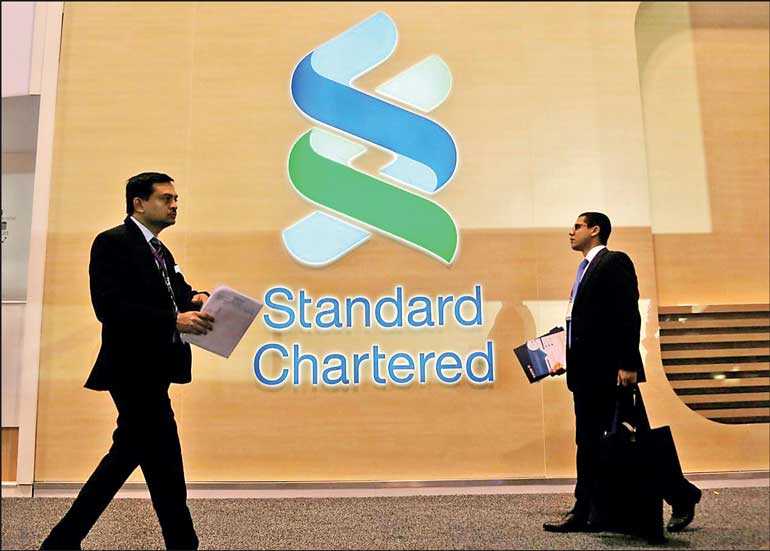Friday Apr 19, 2024
Friday Apr 19, 2024
Friday, 2 August 2019 00:00 - - {{hitsCtrl.values.hits}}

Hong Kong/London (Reuters): Standard Chartered PLC flagged the tit-for-tat tariff war between China and the United States and an easing monetary policy cycle as potential risks for the Asia-focused lender, even as it managed to exceed first-half profit estimates.
The trade war between the world’s two largest economies has raised costs, roiled financial markets and has also triggered analyst concerns about its impact on global banks that handle the bulk of the trade finance related businesses.
Adding to the woes is the reversal in the cycle of rising interest rates, with Hong Kong, which accounts for a bulk of StanChart revenue, cutting its base rate on Thursday for the first time since 2008, after the US Federal Reserve’s downward move.
“Concerns surrounding the potential escalation of trade tensions has affected sentiment and central banks’ commentary is indicating a reversal of monetary policy normalisation,” said StanChart Chief Financial Officer Andy Halford in a statement.
Pretax profit for StanChart, which focuses on Asia, Africa and the Middle East, increased 3% to $2.41 billion in the January-June period from $2.35 billion in the same period last year, the bank said in the statement to the stock exchange.
The latest profit compared with the $2.23 billion average of 11 analyst estimates compiled by Standard Chartered.
The global impact of the trade tensions will “continue to reverberate” throughout 2019, StanChart said.
CEO Bill Winters said in an earnings call that the impact of the trade friction had been “pretty limited” so far.
“But we all recognise that this could get worse, the tariffs could be expanded. Corporations in the US, China and elsewhere are responding to not just what’s happening but what could happen,” he said.
Citigroup last month said trade tensions have discouraged some corporate customers from taking out loans.
US and Chinese negotiators ended a brief round of trade talks on Wednesday with little sign of progress and agreed to meet again in September, prolonging an uneasy truce in a year-long trade war.
StanChart also said that “recent political protests have additionally elevated the risk” in Hong Kong, referring to a wave of protests in the financial hub against a now suspended extradition bill that would see people sent to mainland China for trial in Communist Party controlled courts.
“The Hong Kong situation obviously is more fragile at this particular point in time,” Halford said. While the bank has not seen any direct impact of that on its business, sentiment has been impacted a little bit, he added.
StanChart’s London shares rose 3% after results were unveiled, the best performer on the FTSE 350 banks index, tracking gains in its Hong Kong-listed shares.
Turnaround strategy
StanChart has been making steady progress in its turnaround strategy and, in a sign of confidence about its prospects of growing revenues, the bank in April unveiled plans for an up to $1 billion share buyback, its first such in at least 20 years.
That came after Winters unveiled in February ambitious plans to double return on tangible equity and dividends in three years by cutting $700 million in costs and boosting income.
Winters’ turnaround strategy involves reducing costs, exiting low-return businesses, increasing investments on technology and sharpening focus on products and markets to become competitive and improve profitability.
The bank’s return on tangible equity rose 88 basis points to 8.4 percent at end-June, the statement showed, and StanChart said it was confident its new strategy would help deliver a full-year return on tangible equity greater than 10% in 2021.
StanChart said its core capital ratio, a key measure of financial strength, fell by 68 basis points from end-December last year to 13.5% after factoring in a 39-basis points impact due to the up to $1 billion share buyback program.
It cut its operating expenses by 2.9% in the first half of the year to $5 billion, compared to the same period last year, but said second-half costs are expected to be slightly higher than the first half mainly due to technology investments.
StanChart has become the latest British firm to face protest from shareholders over executive pensions after the bank’s 2019 directors’ remuneration report set out plans to increase Winters’ pension allowance among other measures.
Winters on Thursday said the bank’s board was consulting with shareholders on executive compensation at StanChart, and that he would “happily accept” the result of that process.